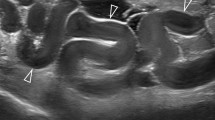Abstract
Background
The undescended testis represents one of the most common disorders of childhood. Laparoscopy has been widely used for the diagnosis and treatment of non-palpable testis. In this study, we investigated and evaluated the usefulness of laparoscopy in the diagnosis and treatment of the non-palpable testis.
Methods
From January 2003 to January 2008, we used laparoscopy in the management of 64 patients with 75 impalpable testes. The patients’ ages varied from 1 to 15 years (median 4.6 years). The sites and sizes of the testes were localized by abdominopelvic ultrasonography (US) in all 64 children. One-stage laparoscopic orchiopexy was performed for 26 testes, staged Fowler Stephens orchiopexy for 17 testes, and laparoscopic orchidectomy for five testes. Follow-up by clinical examination and color Doppler US was performed in every patient who underwent orchiopexy.
Results
There were 11 patients with bilateral non-palpable testes. The overall diagnostic agreement of US with laparoscopy was seen for only 16 of 75 testes (21.3%). The results of diagnostic laparoscopy were varied and showed various pathologic conditions and positions of the testes, such as 20 low intraabdominal testes (26.6%), 17 high intraabdominal testes (22.7%), and 18 testes (24%) that had entered the inguinal canal. Associated inguinal hernia was present in four patients. After a mean follow-up period of 26 months (6 months–5 years) all testes were seen to be located in the bottom of the scrotum, with the exception of three testes that had retracted to the neck of the scrotum and two testes that had atrophied (2.7%).
Conclusions
Laparoscopy has proven to be the only diagnostic modality where the findings provide a clear, dependable direction for definitive management of impalpable testes. It allows an accurate diagnosis and simultaneous definitive treatment.







Similar content being viewed by others
References
Williams EV, Appanna T, Foster ME (2001) Management of impalpable testis; a six year review together with a national experience. Postgrad Med J 77:320–322
Gatti JM, Ostlie DJ (2007) The use of laparoscopy in the management of nonpalpable undescended testes. Curr Opin Pediatr 19:349–353
Barqawi AZ, Blyth B, Jordan GH et al (2003) Role of laparoscopy in patients with previous negative exploration for impalpable testis. Urology 61:1234–1237
Rosito NC, Koff WJ, Olivera TL et al (2004) Volumetric and histological findings in intra-abdominal testes before and after division of spermatic vessels. J Urol 171:2430–2433
Kucheria R, Sahai A, Sami TA et al (2005) Laparoscopic management of cryptorchidism in adults. Eur Urol 48:453–457
Chew H, Hutson JM (2004) Incidence of cryptorchidism and ascending testes in trisomy 21: a 10 year retrospective review. Pediatr Surg Int 20:744–747
Cortesi D, Ferrari P, Zambarda E (1976) Diagnosis of bilateral cryptorchidism by laparoscopy. Endoscopy 1976 8:33–34 Quoted from BJM Int 87:490–493
Scott JES (1982) Laparoscopy as an aid in the diagnosis and management of impalpable testes. J Pediatr Surg 17:14–16
Alam S, Radharkirishnan J (2003) Laparoscopy for non-palpable testes. J Pediatr Surg 38:1534–1536
Argos-Rodriguez MD, Unda-Orpez A, Garcia-Lorezo C (2003) Diagnosis and therapeutic laparoscopy for non palpable testis. Surg Endosc 17:1756–1758
Baker LA, Docimo SG, Surer I et al (2001) A multi-institutional analysis of laparoscopic orchiopexy. BJU Int 87:484–486
Bargawi AZ, Blyth B, Jordan GH et al (2003) Role of laparoscopy in patients with previous negative exploration for impalpable testis. Pediatr Urol 61:1234–1237
Cortesi D, Thorup JM, Beck BL et al (1995) Laparoscopy in 100 consecutive patients with 128 impalpable testes. Br J Urol 75:281–287
Tennenbaum SY, Lerner SE, McAleer IM et al (2000) Preoperative laparoscopic localization of the non palpable testes; a critical analysis of a 10-year experience. J Urol 164:154–155
Chang B, Palmer LS, France I (2001) Laparoscopic orchidopexy: a review of a large clinical series. Br J Urol 87:490–493
Cisek LJ, Peters CA, Atala A et al (1998) Current findings in diagnostic laparoscopic evaluation of the non-palpable testis. J Urol 160:1145–1149
Lotan G, Klin B, Efrati Y et al (2001) Laparoscopic evaluation and management of non-palpable testes. World Surg 25:1542–1545
Ayub K, Williams MP (1998) A simple alternative technique of orchiopexy for high undescended testis. Ann R Coll Surg Engl 80:69–71
Jawad JW (1998) Scroto-peritoneal port for laparoscopic orchiopexy. Pediatr Surg Int 13:460–461
Malone PS, Guiney EJ (1985) A comparison between ultrasonography and laparoscopy in localizing the impalpable undescended testis. Br J Urol 57:185–186
Elder JS (2002) Ultrasonography is unnecessary in evaluating boys with a nonpalpable testis. Pediatrics 110:748–751
Siemer S, Humke U, Uder M et al (2000) Diagnosis of impalpable testes in childhood: comparison of magnetic resonance imaging and laparoscopy in a prospective study. Eur J Pediatr Surg 10:114–118
Desireddi NV, Liu DB, Maizels M et al (2008) Magnetic resonance arteriography/venography is not accurate to structure management of the impalpable testis. J Urol 180:1805–1809
Yeung CK, Tam YH, Chan YL et al (1999) A new management algorithm for impalpable undescended testis with gadolinium enhanced magnetic resonance angiography. J Urol 162:995–999
Cain MP, Garra B, Gibbons MD (1996) Scrotal-inguinal ultrasonography: a technique for identifying the nonpalpable inguinal testis without laparoscopy. J Urol 156:791–799
Yu TJ, Lai MK, Chen WF (1995) Two-stage orchiopexy with laparoscopic clip ligation of spermatic vessels. J Pediatr Surg 30:870–872
Radmayr C, Oswald J, Neureuer P et al (2003) Long-term outcome of laparoscopically managed non-palpable testes. J Urol 170:2409–2411
Author information
Authors and Affiliations
Corresponding author
Rights and permissions
About this article
Cite this article
Ismail, K., Ashour, M., El-Afifi, M. et al. Laparoscopy in the Management of Impalpable Testis: Series of 64 Cases. World J Surg 33, 1514–1519 (2009). https://doi.org/10.1007/s00268-009-0004-8
Published:
Issue Date:
DOI: https://doi.org/10.1007/s00268-009-0004-8




